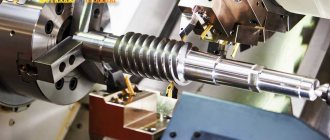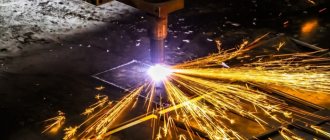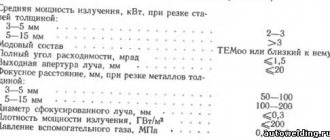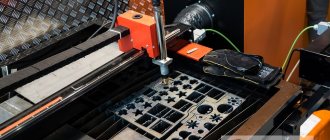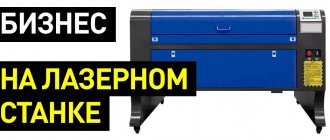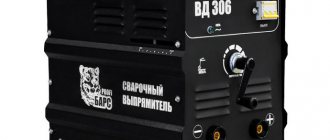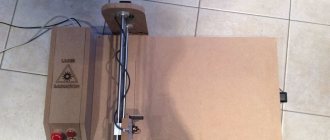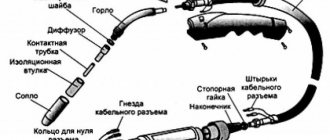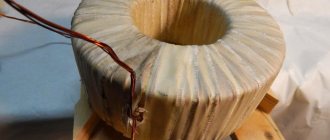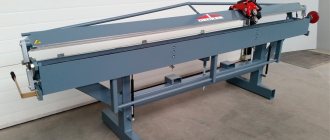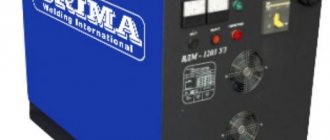Content
- What is laser cutting of metal
- Laser cutting equipment
- What determines the quality of laser cutting?
- Features of cutting certain types of metals
- Alternatives to Laser Cutting
- Practical use
- Pricing when calculating the cost of laser cutting
Plasma cutting
Gas cutting
Waterjet cutting
Laser cutting of metal is the process of heating and destroying metal using a laser beam. The international name of the technology is Laser Beam Cutting (LBC).
Today, there are 3 main ways of working with a metal laser:
- Melting is the most common method and is suitable for a wide range of materials. The laser beam heats the metal surface to its melting temperature, which varies depending on the type of raw material. When the mode is correctly selected, the metal melts only along the cut, the integrity of the edges is preserved. A stream of compressed gas flows into the processing area, which blows out molten metal, cools the edges, and prevents melting and deformation on the cuts. For example, the presence of oxygen when cutting stainless steel or aluminum threatens to oxidize the cut site, so the surface is blown with nitrogen. The movement algorithm is compiled on the basis of information about the material (thickness, melting point) and embedded in the software that controls the actions of the equipment. This technology is highly accurate, fast and cost-effective.
- Combustion is a method of laser metal cutting that optimizes the processing of ferrous metals, but is not suitable for non-ferrous metals and steel with a high content of alloying elements. Exposure to oxygen produces several times more thermal energy than laser operation. The cost of the process and processing time are reduced. The technique has a drawback - the edges of some materials burn. The costs of post-processing the slices can exceed the savings from cutting directly. The choice of laser cutting technology “burning” determines the material. For example, black steel does not form oxides during processing or allows them to be easily removed. Aluminum alloys and stainless steel oxidize when in contact with O₂, so when cutting these materials, the flow of oxygen is cut off with a stream of nitrogen.
- Evaporation is rarely used, it is in demand only when cutting thin-walled products or sheets of small thickness. The beam does not operate as a continuous jet, but in short pulses designed to melt and evaporate the metal without touching anything around it, for example, the substrate (in products). Air pressure removes technical debris from the work area. This technique requires significantly more heating of the material. For example, aluminum melts at 660 ํС and boils at 2,519 ํС. Accordingly, almost four times more energy is needed. The process is more expensive, so it is only justified in cases where other technologies fail.
Thus, laser cutting by fusion method is the optimal price-quality ratio for most materials.
Laser cutting equipment
Devices are classified according to different parameters. Based on the type of working medium—laser radiation source—there are three types of devices:
- Solid State Systems. The lighting module contains a solid working fluid and a high-power gas-discharge lamp. The working fluid can be a rod made of ruby, neodymium glass and other materials. The edges of the rod are equipped with mirrors: translucent and reflective. The laser beam created by the working fluid gains power due to multiple reflections and exits through a translucent mirror.
- Gas devices. They use CO₂ (separately or in combination with helium and nitrogen). Carbon dioxide is activated by electrical discharges. To increase power, a system of mirrors is also used.
- Gas-dynamic devices have the highest power. The active substance is also carbon monoxide (CO₂), heated to a temperature in the range from 726 to 2726 ° C. It is activated using an additional low-power laser beam. Passing through a special nozzle, the gas changes state and becomes a source of radiation. This type of equipment is the most expensive.
The choice of laser cutting type depends on the material to be processed.
CNC machines using carbon dioxide do an excellent job of welding, cutting, engraving metal, glass, plastic and other raw materials. Solid-state equipment is effective for cutting aluminum, copper, silver, and brass. Do not work with non-metallic materials.
The main stages of operation of a laser machine
First, a special drawing is prepared, where the coordinates of the required cuts are indicated - this drawing is loaded into the operating program of the machine. After which, the actual working process begins: the machine automatically directs the beam to a given place and produces strong heating. Glass and metal melt under the influence of elevated temperatures, and wood burns out. In a strictly designated place, the surface to be processed is precisely cut in accordance with the specified parameters.
Laser cutting quality. What does it depend on?
The quality of laser cutting usually means accuracy, cut quality (minimal roughness, straight walls), and speed of service provision.
The result of the work depends on many components:
- Type and dimensions of the part;
- Correct setup of laser cutting equipment;
- Technical condition of the CNC machine;
- Quality of layout development.
To get the desired result, you need to take into account all these parameters. Subject to the rules of use, laser cutters provide accuracy of up to 0.1 mm.
The cutting speed is determined by the power of the equipment, the thickness and thermal conductivity of the material being processed. The higher the indicator, the faster heat is removed from the work area, and accordingly more energy is required. For example, a laser power of 600 watts is enough to cut titanium or ferrous metals, but not enough for copper or aluminum.
Features of cutting individual metals
The individual properties of materials require the use of different laser cutting technologies. Alloys and non-ferrous metals are processed on machines with a power of at least 1 kW; for working with ferrous metals, a power of 0.5 kW will be sufficient.
Cutting of high-carbon steels is carried out mainly using gas-laser technology using oxygen. Due to the strong thermal reaction in the laser impact area, the processing speed of the metal sheet increases.
This method gives high quality cuts. For shaped cutting, for example, workpieces with sharp corners or holes, an inert gas is used in combination with a laser beam.
When processing stainless steel products or sheets, nitrogen is used, which is transported to the working area under pressure of up to twenty atmospheres. Given the high strength of the raw materials, laser cutting is practically the only method for high-quality processing of stainless and galvanized steel.
Working with non-ferrous metals requires devices with more power, for example solid-state type.
To interact with brass, aluminum and alloys containing it, an inert gas is used under pressure of up to ten atmospheres. The edges are of good quality, there may be a slight formation of burr, which is easy to remove.
Copper has high thermal conductivity properties. The optimal thickness of sheets for laser cutting is no more than 0.5 mm. Large thickness requires significant costs, which is not economically feasible.
Laser machines have proven themselves to be excellent in cutting pipes up to 30 mm thick. The cutting line can be directed at any angle. The result is a flat surface, ready for further installation or welding.
Areas of application
Laser machine for metal Wattsan 1530 Basic.
Price 2,800,000 rub. The ability to process almost any material with laser cutting makes the scope of its application quite wide. Of the large number of different production areas, the following, the most famous, can be distinguished:
- metalworking (automotive and aviation industries, shipbuilding, space industry and others);
- woodworking (furniture production, plywood models, cutting parquet boards and others);
- production of advertising products (cutting letters, visual layouts, life-size figures, etc.);
- light and shoe industry (cutting material in ateliers and garment factories, creating patterns, patterns for clothes and shoes, and others);
- production of souvenir and gift products;
- production of seals and stamps;
- Product marking, which is carried out on machines operating on the principle of laser engraving equipment, is distinguished by image clarity and durability.
Interesting: Laser for metal engraving
An alternative to laser cutting of metal
In modern metalworking, four metal cutting technologies are effectively used:
- Laser;
- Plasma;
- Gas;
- Waterjet.
Each method has its own advantages and disadvantages in relation to different types of materials.
Plasma cutting of metal
Plasma cutting is a metal cutting technology in which a plasma jet acts as a cutting tool. The advantages include the ability to work with any raw materials: non-ferrous, refractory and other complex metals. Another advantage of the technology is the creation of cuts of any shape, including complex geometric ones.
Plasma cutting is slightly inferior to laser cutting in terms of edge quality and, accordingly, accuracy. With laser processing, the edges have a greater degree of perpendicularity.
For materials thicker than 6 mm, the plasma method takes less time and energy consumption compared to the laser method. However, when working with thin materials and manufacturing parts with complex geometries, the use of a laser is more effective due to greater accuracy and maximum compliance with the technical specifications.
Gas metal cutting
The essence of the gas cutting process is as follows: acitelen or propane gas heats the processing material to 1000-1200⁰C, then oxygen is connected, which lights up upon contact with the hot metal and cuts it. The technology is suitable for materials whose combustion temperature is lower than the melting temperature: for steels with low and medium content of alloying elements. The advantages of the method are low cost, simplicity, and mobility of equipment. However, it is not suitable for all materials; the cutting accuracy is significantly inferior to laser and plasma.
Waterjet cutting of metal
The working tool for waterjet cutting is a mixture of water with abrasive particles (grains of silicon carbide, electrocorundum, other solids, garnet sand). Water enters the cutting head under pressure of up to 6000 atmospheres, from there it rushes out into the chamber at a speed of about 1000 m/sec (and higher), where it mixes with the abrasive. The mixed jet destroys the integrity of the metal and washes away the cut off particles. An important feature of waterjet cutting is that the surfaces being processed practically do not heat up, which gives the method a lot of undeniable advantages.
The technology has a number of advantages:
- Work with any materials;
- High quality of cut due to the absence of burning and melting of the surface;
- Possibility of processing heat-sensitive raw materials;
- No harmful emissions in the work process;
- Fire safety of work.
Disadvantages include lower speed compared to plasma and laser processing, high cost of equipment and cost of the process.
Of the options considered, laser cutting is the most versatile tool. In addition to direct cutting, the devices are used for laser metal engraving, marking, marking and other operations.
Types of processing equipment
The variety of technical tasks and requirements for processed parts using laser cutting make this equipment market very broad in design. Classification into categories can be based on the type of active medium, the type of excitation energy, the purpose, the degree of automation of the equipment, the size range and power of the installation.
With gas and solid state sources
One of the important elements of a quantum generator is the active medium. Existing equipment based on the type of active medium can be equipped with both gas and solid-state units. They differ from each other by the wavelength of the radiation. This parameter affects the transparency when beam energy is absorbed by various materials.
Universal standard machine with carbon dioxide laser TruLaser 3030/3040. Price 17,000,000 rub.
The wavelength of gas installations is well perceived by non-metallic materials - wood, plastic, leather and others. Solid-state ones produce a beam with a wavelength that works effectively with metals.
CNC complexes
The technological process of laser cutting is not difficult to automate using numerical control. The laser installation is capable of moving along the most intricate trajectory while maintaining high speed. Complex maps for cutting metal sheets using solid-state machines or contours in the form of an artwork on sheets of plywood using gas lasers can be done on a programmable machine.
CNC metal laser cutting machine GF3015/4020 Plus. Price 2,500,000 rub.
Tabletop, compact and floor-standing
For large industries, where the volume of production using laser technology approaches the maximum equipment load, the use of portal laser cutting machines is optimal. The dimensions of the machine are determined by the dimensions of the work table. The option with a large desktop or a slightly smaller one (medium format) is most widespread.
Interesting: Laser cutting of aluminum
Compact automated laser cutting installation BODOR i5-1000W. Price 3,900,000 rub.
Laser engraving machines, which are used to make, for example, small souvenir products, must be compact so that they can be placed on the desktop in the workshop.
Mini, small
In addition to being used in large-scale industries, programmable machines with a laser system are used in small businesses and home workshops, for example, as an assistant in the manufacture of original hand-made products. Such equipment is small in size and can fit on a regular home desk. Apart from the difference in size and lower power, the rest of the mini-machines are no different from professional equipment, maintaining cutting accuracy and edge quality.
Hand cutters
The use of a laser machine as a hand-held cutting device is limited by its weight and overall dimensions. Therefore, the radiation source does not have sufficient power to cut metal; cooling must maintain thermal balance by natural transfer of the generated heat to the environment. Manual laser cutting is effective for processing fabrics, leather and other similar materials.
Fiber optic devices
Solid-state lasers, in which doped quartz glass fiber acts as the active substance, are called fiber lasers. They have a smaller focusing diameter than gas and solid-state crystal lasers. This allows for faster heating and increased cutting capabilities by creating complex contours that would not be possible with other types of laser equipment.
Unpretentiousness in operation due to simpler setup and requirements for preventive maintenance (cleaning, adjustment), the absence of special requirements for air purity and room humidity increase the competitiveness of fiber optic devices compared to other similar types of equipment.
Diode lasers
The main element of a diode laser is an emitter in the form of a laser diode - a semiconductor crystal formed in the form of an optical resonator. In addition to the diode, the diode laser includes a special power supply device, with which you can change the parameters of the output radiation, a temperature control device, and an optical device that increases the monochromaticity of the laser diode radiation.
However, the diode laser is still much inferior to other types of lasers in the degree of coherence and monochromaticity of the radiation. Large divergence in focusing does not allow achieving maximum energy concentration. The main advantage is the relative cheapness of diode lasers compared to other types.
Laser diodes are widely used as controlled light sources in fiber-optic communication lines, in measuring equipment (laser rangefinder), laser pointers and target designators, for reading bar codes and other fields of technology.
Practical application of laser cutting technology
The production of products using laser equipment consists of several stages:
- Formation of a product idea.
- Development of an artistic sketch.
- Creation of a technical model of the model.
- Manufacturing a test part on a CNC machine.
- Monitoring parameters and making modifications if necessary.
- Launch of mass production.
Special attention must be paid to the creation of a technical layout, since the quality of the finished product will depend on its accuracy.
The machines use AutoCAD and CorelDraw program formats, so drawings for laser engraving or cutting must be made in these programs.
Requirements for layouts for laser cutting
- Drawing scale 1:1.
- Closed external and internal contours.
- CIRCLE, LINE, ARC – commands for creating contours.
- The ELLIPSE and SPLINE commands are not supported.
- By overlapping lines, the laser cutter will follow the same path multiple times.
- The drawing for laser cutting must indicate the number of parts and working material.
- All information about the drawing must be placed in one file.
Pricing for metal laser cutting services
The price of services depends on a number of components and varies depending on the technical specifications.
What affects the cost of metal laser cutting services?
- Type of metal. For example, cutting ferrous metals, steel and stainless steel costs 2-3 times less than cutting copper, brass, titanium, aluminum and its alloys.
- Sheet thickness. The greater the thickness, the higher the price. Non-standard technical specifications are calculated individually.
- Complex shapes of parts. The more cuts required to achieve the result, the higher the price.
These and a number of other parameters, which are negotiated with the customer, determine the cost of laser cutting and engraving.
Laser tube ignition unit
You can return to the previous drawing - this block is signed. Quite a massive black box. Another important element of a laser machine. In order for the tube to work, this unit raises the voltage at its terminals to a voltage of more than 20 kV and raises it until a discharge begins in the tube. If the tube fails and the discharge never begins, the high-voltage unit will either turn off or continue to produce the highest possible voltage, which can damage it.
Let's assume that the tube is working properly and the discharge has begun - now the high-voltage unit turns on the current stabilizer to maintain the required current, regardless of the load in the circuit. The voltage usually decreases.
